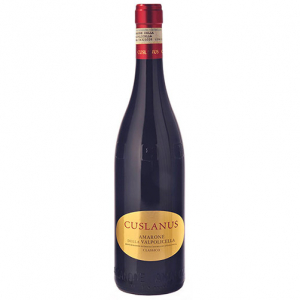Amarone
Amarone wines are produced in the legendary wine-making area of Valpolicella, in the Veneto region in the north-east of Italy. Also referred to by the name of Amarone della Vapolicella, denoting its geographical provenance, this wine is not to be confused with straight Valpolicella, another red wine produced in the same area. Although the two use the same grapes, Valpolicella is a younger, less complex wine than its older brother, Amarone. You could in any case be forgiven for not being overly familiar with the grapes used to produce this 'wine of wines’: Corvina Veronese, Corvinone, Rondinella and Molinara are not widely planted outside of the Valpolicella region. The first two tend to make up the majority of any blend, with the latter two added to complete their expression as the sommelier sees fit.
Legend has it that Amarone was first produced as the result of an oversight by a cellar manager, by the name of Adelino Lucchese. As the story goes, he forgot about an entire barrel of sweet Recioto wine, which thus ended up being left in the cellar for several months more than intended. Certain he would be dismissed for his error, he called in the winemaker to confess, only for them both to discover that the wine had in fact developed into something very special. The yeasts had kept the fermentation going and used up all the sugars in the liquid, turning it into a dry wine.
How are Amarone wines produced? Amarone is a ‘passito’ wine – that is, it is made with hand-selected grapes that have been left to dehydrate on straw mats in rooms whose temperature is carefully monitored. The drying process alone can take up to four months. The resulting semi-raisins are then pressed before undergoing a slow fermentation at relatively low temperatures, giving rise to a densely concentrated and flavorsome wine whose alcohol content hovers somewhere between 14 and 16.5 ABV. Aging takes place in oak or chestnut barrels, for a period of at least two years, allowing all the nuances of this luxurious tipple to mellow and deepen. In the case of the Riserva, aging is extended to an impressive four years. Amarone Classico on the other hand is produced in an even more restricted geographical area, encompassing the original growing zone – in particular around Sant’Ambrogio and San Pietro.
What is Amarone’s taste profile? This is a powerful and incredibly persistent wine – not one for the faint-hearted. However, those who dare will not be disappointed. Amarone wines are velvety-smooth and richly complex, presenting a range of intense flavors from candied red fruits to spices such as cinnamon, along with rich depths hinting at chocolate and cocoa.
As it concerns the best Amarone della Valpolicella wines, few would argue that among the great Amarone-producing wineries, Masi, Tommasi and Bertani deserve pride of place. Bertani is probably the largest of the three in domestic terms, with over 200 hectares of vines in the region, planted according to a family tradition that dates back to 1857. Masi, on the other hand, also owns estates in Argentina, and produces two Amarone wines – Mazzano and Costasera – which unceasingly receive industry accolades, year upon year.
What food goes well with Amarone? In short, think anything that is big on flavor: game meat and wild fowl – pigeon or pheasant for example – or rich meat stews such as ossobuco would be perfect. Just steer clear of anything too acidic or fried.
You viewed of 39 products
Show more



























